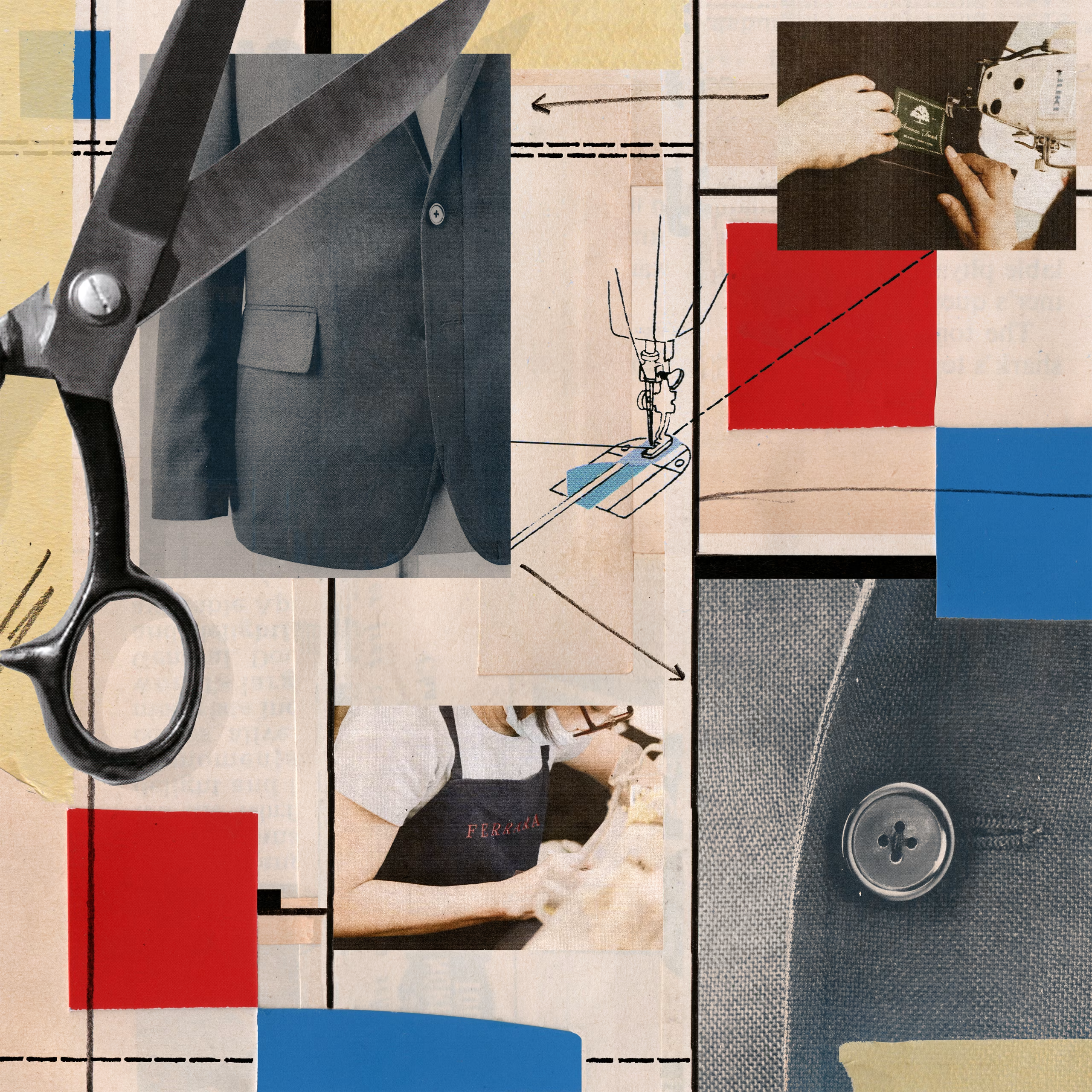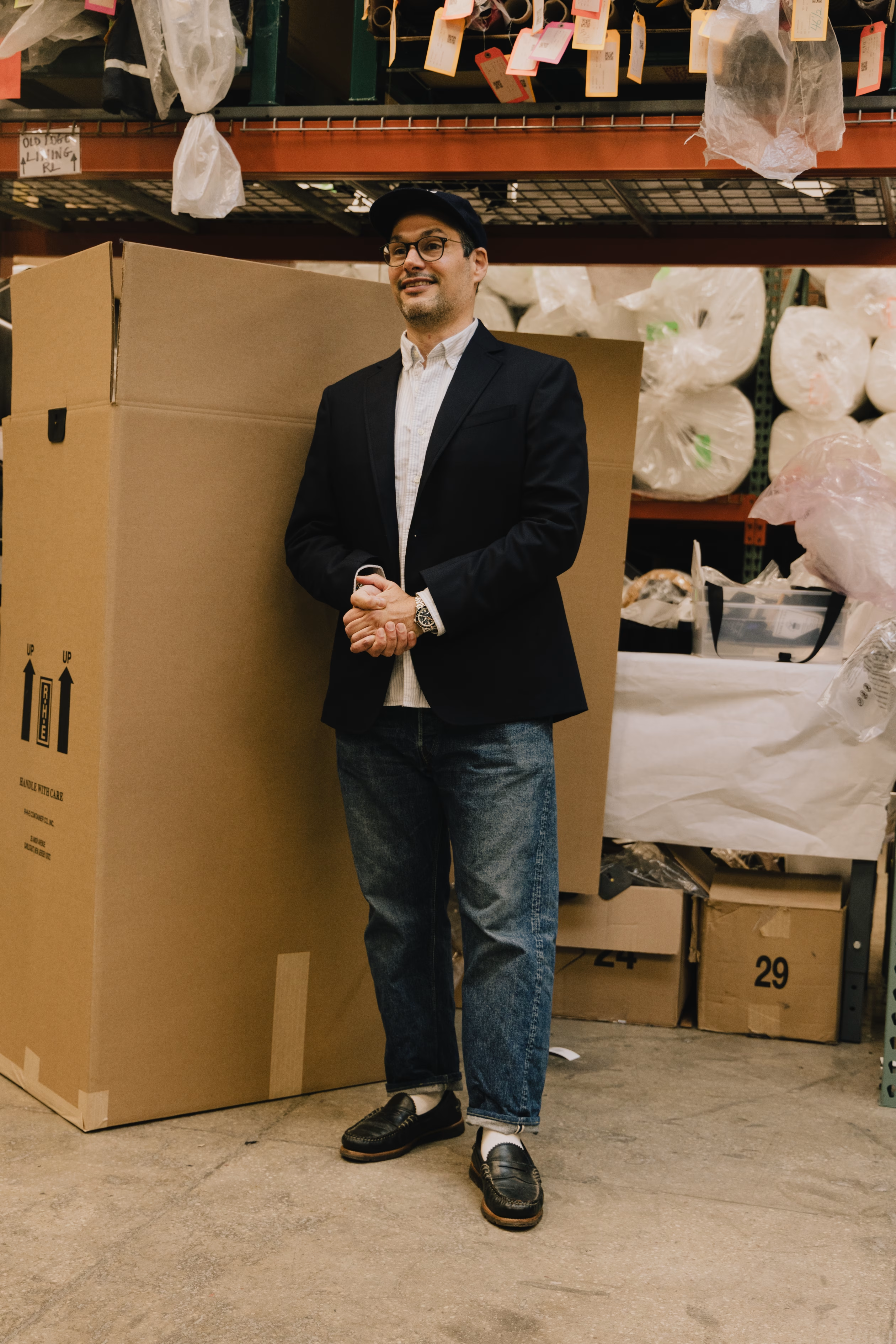A look into the process of making a classic garment entirely in the U. S.—from sheep farmers to local factories—revealed the challenges and opportunities of American manufacturing.

American Trench sought to produce an iconic piece of American design: the classic navy blazer. But actually making one in America was easier said than done. Illustration: Jordan Bohannon; American Trench, Getty Images
Jacob Hurwitz started his company, American Trench, in 2013 with a trench coat and seven pairs of socks, all designed and produced in the United States.
In the years that followed, he expanded American Trench’s range with items such as canvas trousers, oxford shirts and mesh shorts, that were all made in America—and, when possible, made from materials themselves sourced or produced here, too.
“It was all I wanted to do. If I couldn’t make it here, I wasn’t interested,” he said recently, sitting in his office in Ardmore, Pa.
As he and his small team built out their offering, one garment in particular eluded him: the classic navy blazer, beloved by country club members and public-school teachers alike.
It’s an iconic piece of American design. But actually making one in America is easier said than done.
A Designer’s Labor of Love
The Trump administration’s proposed tariffs are meant to reinvigorate American manufacturing. But stiff import taxes can’t instantaneously address two stark and interconnected facts that designers face: There are significantly fewer American factories capable of producing high-quality textiles and clothing than there once were, and doing so is more expensive here than in other countries to begin with.
Today, Hurwitz explained, some 98% of the clothing purchased by Americans is imported—a precise inversion, he notes, of the proportion during the country’s midcentury manufacturing peak.
And much of the know-how, to say nothing of the production capacity, has disappeared as clothing companies shipped production overseas.
“We not only lost machines and spaces and capacity, we also lost the people who knew how to do this,” said Rachel Slade, author of “Making It in America.”

Jacob Hurwitz started his company, American Trench, in 2013 with a trench coat and seven pairs of socks, all designed and produced in the United States. Photo: American Trench
In the decade he’s run American Trench, Hurwitz has assembled a personal Rolodex of the country’s remaining textile producers and clothing factories. But even over that span, he said, plenty of his suppliers and factories have shuttered.
Making clothing in America, Hurwitz knew, was a labor of love—more time-consuming, more expensive, and a harder sell to price-conscious customers. As Alex Goulet, the co-author with Willy DeConto of “Crafted With Pride,” a directory of made-in-USA brands, put it, “The person that is looking to make things here is maybe looking beyond just dollars, beyond profit margins. You really have to be committed ideologically to doing something different.”
A Wool Mill’s Ambitions
Jacob Hurwitz is one of those people. Another is Jacob Long, who led the 2014 purchase of a shuttered wool mill in Stafford, Conn., from the Italian luxury brand Loro Piana.
With his company, American Woolen, Long has devoted himself to re-establishing the Northeast as a hub for high-end clothing manufacturing. Long saw it as a sort of math problem: the U.S. exports some 60% of the wool it produces each year (22.5 million pounds in 2024), much of it to China. American consumers, in Long’s telling, turn around and spend billions to import finished wool products.
“So you have a nice supply upstream. You have pretty good demand. And yet there’s a lack of a midstream link,” Long said. “As American Woolen, we’re trying to work on that link.”
One day Hurwitz got a call from Long, who more or less insisted he grab the next train to New York to tour a family-owned factory in Queens called Ferrara Manufacturing.
“He was like, You have to visit,” Hurwitz said. “So I went and visited.” Hurwitz was flabbergasted. In his estimation, the tailored clothing the Ferraras were capable of producing could stand next to anything from Italy or the U.K.
A Thoroughly Modern Factory
Since the early ‘90s, Ferrara Manufacturing has specialized in making high-quality tailored clothing. Women’s suiting was an early specialty; they’ve since expanded into men’s tailoring, along with shirts, pants and outerwear. Ralph Lauren is one longtime client, and more recently the Ferraras have found success making dress uniforms for the military.
The factory is a dramatic $25 million concrete-floored behemoth occupying the better part of a city block in Long Island City. On a recent visit, Gabrielle Ferrara, the company’s second-generation president and COO, walked through the many steps that yield the tailored clothing the factory specializes in.

Since the early ‘90s, the Queens family-owned factory Ferrara Manufacturing has specialized in making high-quality tailored clothing. Photo: Jessica Foley for WSJ
The Ferraras have invested heavily in technology in the hopes of making a distinctly 21st-century clothing factory: in addition to classic sewing machines, there’s a wall of 3-D printers used to make sewing tools that improve efficiency. Elsewhere on the floor, one hulking machine can cut striped fabric in such a way that everything lines up perfectly on a finished garment.
Hurwitz and Ferrara began working on a design for his blazer. After trying on one sample the Ferraras had on hand, Hurwitz knew he wanted something a little baggier—more like the traditional, Brooks Brothers-style “sack suit” that is a hallmark of American tailoring.
They worked from an existing sample closer to his ideal, and then started poring over details: they increased the size of the armholes, and spent hours talking about pocket construction. The body would be made of a wool-hopsack fabric, woven by Long’s American Woolen from fiber sheared off sheep raised in Colorado.
Hurwitz put in an order for 100 blazers, at a cost of about $300 per item—the bulk of them in Long’s navy hopsack, plus a few more made of heartier fall fabrics. This was Ferrara’s minimum required for production, but a not-insignificant quantity for a small company like American Trench.
“It was a big nut, and we had never sold a product like this before. So it was a giant capital risk,” Hurwitz said.

The blazer’s body is made of a wool-hopsack fabric, woven by Jacob Long’s American Woolen from fiber sheared off sheep raised in Colorado. Photo: American Trench
Building out an American Brand
Still, it represented an effort at diversification: 60% of the American Trench’s revenue comes from its made-in-America socks, which start at $14 a pair. “We don’t want to just be a sock brand and have to sell, you know, hundreds of orders a day to survive,” he said.
A blazer like this one, Hurwitz said, would typically sell for more than $1000, accounting for materials, labor and overhead. Ultimately, though, he decided to price it at $795, in hopes that doing so would draw more customers. “It just felt like we weren’t going to sell any if we put it at $1100,” he said. “Unfortunately, we don’t have the pedigree to do that. We have to offer some kind of value to be, like, Yes, take a chance on this. You know, it punches up.”
Unlike cheaper jackets, which fuse a lining to the wool exterior, American Trench’s use a more time-consuming (and more expensive) technique called half-canvas construction.
Since launching the jacket last fall, Hurwitz has sold nearly half the initial run in navy, and has plans for continued production. The idea, he said, is for the blazer to become a core piece of the American Trench offering.
And while the Trump administration’s tariffs are intended to boost American manufacturing of the sort Hurwitz, Ferrara and Long practice, the trio think the ideal outcome is more nuanced than a return to full industrialization.
“In general, I think we should be making specialized product here in the U.S. We shouldn’t be sending that overseas,” Ferrara said.
Long echoed her point. “You don’t go to Italy to buy commodity, you go to Italy to buy luxury,” he said. “You should not come to America to buy commodity. You should come to buy luxury.”
Sam Schube | WSJ
May 24, 2025 11:00 am ET
